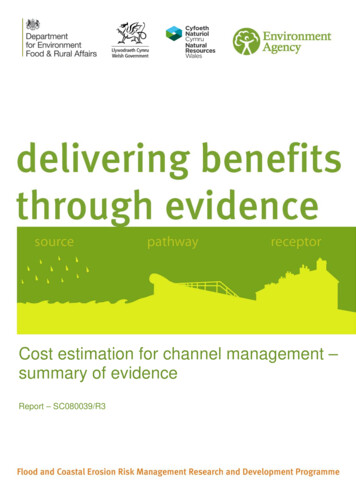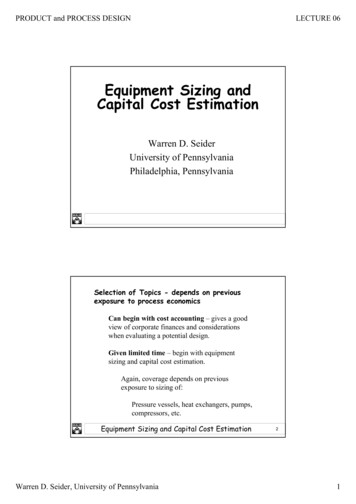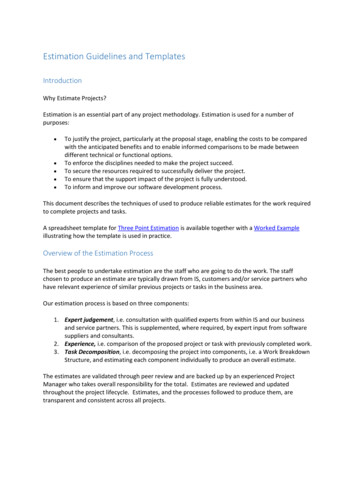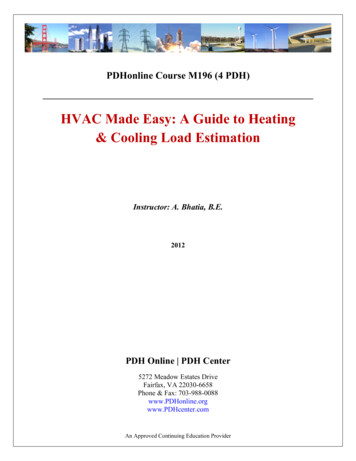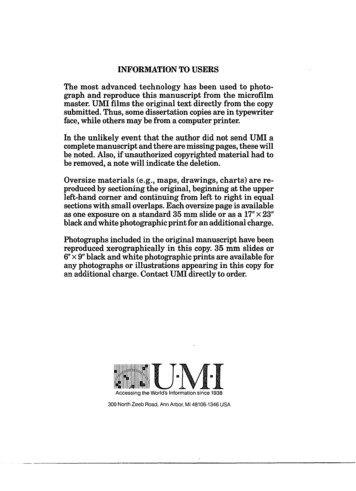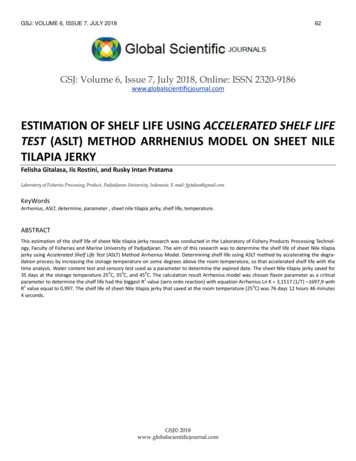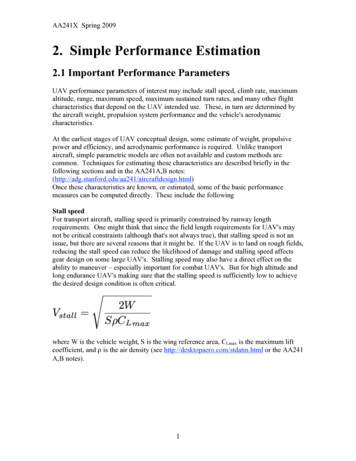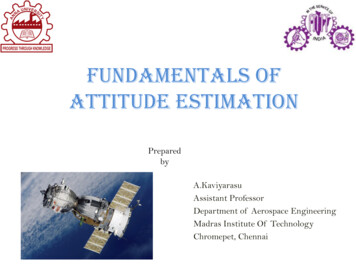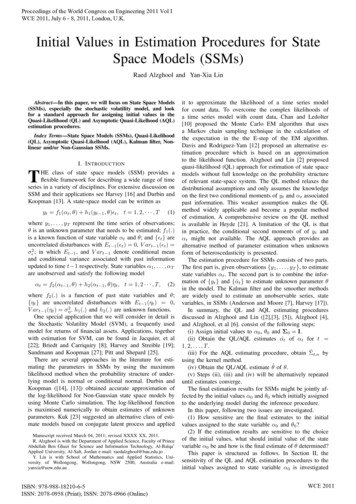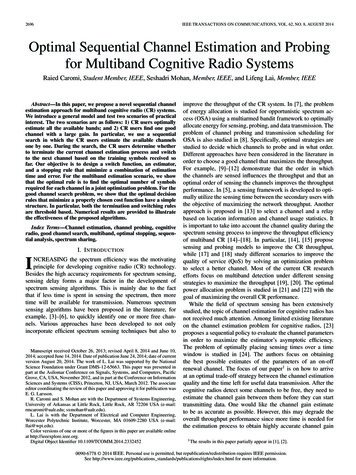
Transcription
2696IEEE TRANSACTIONS ON COMMUNICATIONS, VOL. 62, NO. 8, AUGUST 2014Optimal Sequential Channel Estimation and Probingfor Multiband Cognitive Radio SystemsRaied Caromi, Student Member, IEEE, Seshadri Mohan, Member, IEEE, and Lifeng Lai, Member, IEEEAbstract—In this paper, we propose a novel sequential channelestimation approach for multiband cognitive radio (CR) systems.We introduce a general model and test two scenarios of practicalinterest. The two scenarios are as follows: 1) CR users optimallyestimate all the available bands; and 2) CR users find one goodchannel with a large gain. In particular, we use a sequentialsearch in which the CR users estimate the available channelsone by one. During the search, the CR users determine whetherto terminate the current channel estimation process and switchto the next channel based on the training symbols received sofar. Our objective is to design a switch function, an estimator,and a stopping rule that minimize a combination of estimationtime and error. For the multiband estimation scenario, we showthat the optimal rule is to find the optimal number of symbolsrequired for each channel in a joint optimization problem. For thegood channel search problem, we show that the optimal decisionrules that minimize a properly chosen cost function have a simplestructure. In particular, both the termination and switching rulesare threshold based. Numerical results are provided to illustratethe effectiveness of the proposed algorithms.Index Terms—Channel estimation, channel probing, cognitiveradio, good channel search, multiband, optimal stopping, sequential analysis, spectrum sharing.I. I NTRODUCTIONINCREASING the spectrum efficiency was the motivatingprinciple for developing cognitive radio (CR) technology.Besides the high accuracy requirements for spectrum sensing,sensing delay forms a major factor in the development ofspectrum sensing algorithms. This is mainly due to the factthat if less time is spent in sensing the spectrum, then moretime will be available for transmission. Numerous spectrumsensing algorithms have been proposed in the literature, forexample, [3]–[6], to quickly identify one or more free channels. Various approaches have been developed to not onlyincorporate efficient spectrum sensing techniques but also toManuscript received October 26, 2013; revised April 8, 2014 and June 10,2014; accepted June 14, 2014. Date of publication June 24, 2014; date of currentversion August 20, 2014. The work of L. Lai was supported by the NationalScience Foundation under Grant DMS-12-65663. This paper was presented inpart at the Asilomar Conference on Signals, Systems, and Computers, PacificGrove, CA, USA, November 2012, and in part at the Conference on InformationSciences and Systems (CISS), Princeton, NJ, USA, March 2012. The associateeditor coordinating the review of this paper and approving it for publication wasE. G. Larsson.R. Caromi and S. Mohan are with the Department of Systems Engineering,University of Arkansas at Little Rock, Little Rock, AR 72204 USA (e-mail:rmcaromi@ualr.edu; sxmohan@ualr.edu).L. Lai is with the Department of Electrical and Computer Engineering,Worcester Polytechnic Institute, Worcester, MA 01609-2280 USA (e-mail:llai@wpi.edu).Color versions of one or more of the figures in this paper are available onlineat http://ieeexplore.ieee.org.Digital Object Identifier 10.1109/TCOMM.2014.2332452improve the throughput of the CR system. In [7], the problemof energy allocation is studied for opportunistic spectrum access (OSA) using a multiarmed bandit framework to optimallyallocate energy for sensing, probing, and data transmission. Theproblem of channel probing and transmission scheduling forOSA is also studied in [8]. Specifically, optimal strategies arestudied to decide which channels to probe and in what order.Different approaches have been considered in the literature inorder to choose a good channel that maximizes the throughput.For example, [9]–[12] demonstrate that the order in whichthe channels are sensed influences the throughput and that anoptimal order of sensing the channels improves the throughputperformance. In [5], a sensing framework is developed to optimally utilize the sensing time between the secondary users withthe objective of maximizing the network throughput. Anotherapproach is proposed in [13] to select a channel and a relaybased on location information and channel usage statistics. Itis important to take into account the channel quality during thespectrum sensing process to improve the throughput efficiencyof multiband CR [14]–[18]. In particular, [14], [15] proposesensing and probing models to improve the CR throughput,while [17] and [18] study different scenarios to improve thequality of service (QoS) by solving an optimization problemto select a better channel. Most of the current CR researchefforts focus on multiband detection under different sensingstrategies to maximize the throughput [19], [20]. The optimalpower allocation problem is studied in [21] and [22] with thegoal of maximizing the overall CR performance.While the field of spectrum sensing has been extensivelystudied, the topic of channel estimation for cognitive radios hasnot received much attention. Among limited existing literatureon the channel estimation problem for cognitive radios, [23]proposes a sequential policy to evaluate the channel parametersin order to maximize the estimator’s asymptotic efficiency.The problem of optimally placing sensing times over a timewindow is studied in [24]. The authors focus on obtainingthe best possible estimates of the parameters of an on-offrenewal channel. The focus of our paper1 is on how to arriveat an optimal trade-off strategy between the channel estimationquality and the time left for useful data transmission. After thecognitive radios detect some channels to be free, they need toestimate the channel gain between them before they can starttransmitting data. One would like the channel gain estimateto be as accurate as possible. However, this may degrade theoverall throughput performance since more time is needed forthe estimation process to obtain highly accurate channel gain1 Theresults in this paper partially appear in [1], [2].0090-6778 2014 IEEE. Personal use is permitted, but republication/redistribution requires IEEE permission.See http://www.ieee.org/publications standards/publications/rights/index.html for more information.
CAROMI et al.: OPTIMAL SEQUENTIAL CHANNEL ESTIMATION AND PROBING FOR MULTIBAND CR SYSTEMSestimates. Therefore, there exists a trade-off between the qualityof the channel estimation and the time left for transmission. Inthis paper, we study how to quickly and accurately obtain channel estimates for cognitive radios. We consider two scenariosin which we either estimate all the available channels or wefind one good channel. In both cases, a tradeoff is consideredbetween time, channel gain and estimation error. In particular,the following two cases of practical interest are studied in thecontext of a multiband CR setup: 1) the CR pair quickly getsaccurate channel gain estimates of all free channels; and 2) theCR pair quickly and accurately searches for a channel with alarge gain from the set of free channels.In the first case, there are multiple channels that have beenidentified to be empty through one of the channel scanningalgorithms such as the one developed in [6]. The goal is to getaccurate gain estimates of these channels with a minimal number of training symbols. For this case, we consider a sequentialestimation setup in which the cognitive radio pair obtainsestimates of the channel gains one by one. Furthermore, thechannel estimation process within a channel is also a sequentialone. More specifically, instead of fixing the number of trainingsymbols used in each channel, the transmitter keeps sendingtraining symbols over a channel. Once the receiver obtains areasonably good estimate of the channel gain, it sends a switchsignal to the transmitter. After receiving the switch signal, thepair then proceeds to estimate the next available channel. Theprocess terminates once the CR pair estimates the gains of allthe channels. To strike a balance between the estimation errorand the time required for training, we use a linear combinationof the estimation variance and the total training time as the costfunction. Our goal is to design switching rules and estimatorsthat jointly minimize this cost.In the second case, the goal is to find only one channelwith a large channel gain. We again consider a sequentialsetup in which the CR pair sequentially inspects these freechannels. When the CR pair inspects a particular channel,sequential estimation is used. After each step of the sequentialestimation, the CR pair needs to make the following decisions:1) whether to accept the channel currently under inspectionas a good channel and terminate the search process; and 2) ifthe CR pair decides to continue the search process, the pairneeds to decide whether to stay in the same channel to takemore samples for more accurate channel estimation or switchto another channel in the hope of finding a better channel.Three performance quantities are of interest: the time spenton estimating the channel, the gain of the channel in whichthe process is terminated, and the estimation error. Clearly, thesmaller is the time spent on the channel estimation process,the larger is the time left for data transmission. Similarly, thelarger the channel gain and the smaller the estimation error are,the better. However, there are various tradeoffs among thesequantities. Our goal is to design the optimal termination andswitching rules that maximize the throughput of the CR pair.Using the theory of optimal stopping [25]–[27], we show thatthe optimal rules that minimize a properly chosen cost functionare threshold rules. In particular, the CR pair can make thedecision based on a sufficient statistic designed for this case.Once this statistic crosses a certain threshold, the CR pair will2697Fig. 1. System model.switch to another channel. Once the statistic crosses anotherthreshold, the CR pair will terminate the search process andstart data transmission over the channel.The reminder of this paper is organized as follows. Thesystem model is introduced in Section II. In Section III, westudy the multiband estimation case. The sequential good channel search problem is studied in Section IV. In Section V,we provide numerical results and evaluate the performanceto demonstrate the optimal solutions for all cases. Finally,concluding remarks are provided in Section VI.II. S YSTEM M ODELConsider a primary communication system with multiplebands, among which M bands have been identified as unoccupied during the detection session.2 We consider a block channelfading model between the CR transmitter and receiver, withchannels being independent of each other. Furthermore, weassume uncorrelated white Gaussian noise (WGN) over eachchannel. During the channel estimation process, the receivedsignal at the CR receiver for band k at each time slot j isX(k,j) S(k,j) h(k,j) w(k,j) ,(1)in which S(k,j) is the transmitted training signal from theCR transmitter in channel k with average power S̄ and isknown during the estimation session, h(k,j) is the channelgain coefficients with distribution N (0, σk2 ) and w(k,j) is2). We denotei.i.d. Gaussian noise with distribution N (0, σw2the ratio between the power of the transmittedby γ S̄/σwsignal and noise. Furthermore, we assume that the channel isstationary during the estimation session.We are interested in either estimating all the available channels or quickly searching for one good channel. In both cases,we aim to design an estimator, a switching function and atermination rule for the receiver based on the received trainingsymbols X(k,j) (x(k,1) , x(k,2) . . .). Let φj denote the switching function and Fj the set of observations received until timej. Let φj (Fj ) {0, 1} be the switching decision function, withφj (Fj ) 1 if we decide to switch to the next channel fortraining and φj (Fj ) 0 if we decide to continue observingin the same channel. Furthermore, let φ̄ {φ1 , φ2 , . . .}. Fig. 1shows a typical operation of the proposed sequential estimationmodel, where Nk is the number of training symbols used forestimating channel k. More specifically, the CR users start2 In this paper, we assume that the detection is perfect. The impact ofdetection error will be considered in a future work.
2698IEEE TRANSACTIONS ON COMMUNICATIONS, VOL. 62, NO. 8, AUGUST 2014from the first channel and continue until the whole processis terminated. Following from this, the time index j takes thefollowing valuesfactors are functions of the number of training symbols, R(k)is non-convex in the number of training symbols. Therefore,the use of the rate equation directly as a utility function forthe sequential model will result in a hard to solve non-convexoptimization problem. Furthermore, we will use a techniquesimilar to the one developed in [28] to evaluate a lower-boundon the data rate. In the following sections, we will show how toappropriately choose the loss function that results in the desiredtrade-off while keeping the solution as simple as possible. Wewill consider two different scenarios. In the first scenario, theCR users need to estimate all the available channels quicklyand accurately within a given time constraint. In the secondscenario, the CR users need to quickly find one good channelwith large gain without necessarily exploring all the availablechannels. Relying on the results from the optimal stoppingtheory and convex optimization, we obtain optimal solutionsfor both scenarios.j 1 . . . N1 , (N1 1) . . . (N1 N2 ), . . . . . . , k 1 k Ni 1 . . .Ni , . . . , k 1, 2, . . . . . .i 1(2)i 1Assume that the maximum training session time is upperbounded by T αTt , where α is a constant 0 α 1 andTt is the total transmission session time. The general Bayesianoptimization problem is to determineinf E[Lτ cτ ],τ,φ̄,ĥs.t. τ T,(3)where ĥ (ĥ1 , . . . , ĥk , . . . , ĥM ) is the estimated channelgains, Lτ is the loss function related to the quality of thechannel estimations, c is the cost of training symbols, and τ isthe stopping time. The problem in (3) is a linear combinationof the loss and cost of sampling. This formulation gives usa trade-off between loss and estimation delay under a timeconstraint. Since the final goal is to maximize the throughputof cognitive radios, the cost function Lτ should reflect thetotal throughput of CR users while being simple enough forquantitative analysis. The general form of the rate equation forchannel k can be written as τ(4)log2 (1 SN R),R(k) 1 Ttin which (1 (τ /Tt )) represents the fraction of the time leftfor data transmission.Clearly, SNR in (4) represents the signal-to-noise ratio at thereceiver side during the data transmission session. This SNRcan be computed from the received signal, which depends onthe transmitted signal, channel gain, and additive noise. Thechannel gain can be computed using any estimation technique,which will consequently result in some error from the estimation process. Assuming minimum mean-square error (MMSE)estimate and following a similar approach to [28], we can modelthe estimation error at channel k asȟ(k,j) h(k,j) ĥ(k,j) .In this section, we consider the scenario in which we need toestimate the channel gains of all the available channels undera time constraint. In this case, the channel estimation problemhas two effects on the overall achievable throughput. First, wewant to reduce the number of symbols required by the channeltraining process so that more time is left for data transmission.Second, we want to reduce the channel estimation error, which,however, requires a longer training period. In this scenario, weare interested in estimating all the available channels. Hence,without loss of generality, the CR users start from band 1 andcontinue until the last band k M , while continuing to makethe switch-continue decisions based on φj (Fj ). Since we willestimate all the available channels, we are more interested inmaximizing the effective SNR at the receiver side for all thechannels.Denote by L(k) the loss incurred in channel k during theestimation process. Our new goal is to design a switch functionφ̄ and estimates ĥ that minimize the total cost incurred for theseM channels. That is, the optimization problem in (3) can bewritten as M L(k) cNk ,r inf Eφ̄,ĥ(5)During the data transmission phase, the received signal willbe affected by the estimation error term. Hence, we canwrite (1) asX(k,j) S(k,j) ĥ(k,j) S(k,j) ȟ(k,j) w(k,j) , III. T HE M ULTIBAND E STIMATION C ASE(6)s.t.k 1M Nk αTt ,(7)k 1where r is the total risk incurred after we complete the estimation process.ẃ(k,j)in which ẃ(k,j) represents the sum of the received noise and thepart of signal that is affected by the estimation error. Clearly,the effective SNR at the receiver side will be affected by theestimation error, which we will evaluate in Section III-A. Inthe meantime, we know that the rate R(k) is proportional tothe time, gain, estimation error, and noise. Since all theseA. The Loss FunctionTo illustrate the idea, we first focus on the estimation ofa single channel k. We use rk to denote the risk incurred inchannel k, i.e.,rk L(k) cNk .(8)
CAROMI et al.: OPTIMAL SEQUENTIAL CHANNEL ESTIMATION AND PROBING FOR MULTIBAND CR SYSTEMSAt time j, using the channel model of (1) and choosing theaverage of squared error (ĥ(k,j) , h(k,j) ) (h(k,j) ĥ(k,j) )2as the loss function (i.e., we focus on the MMSE estimate)associated with channel k L(k,j) ĥ(k,j) ; X(k,j) E ĥ(k,j) , h(k,j)h(k,j) ĥ(k,j) , h(k,j) π h(k,j) x(k,j) dh(k,j)(9)where π(h(k,j) x(k,j) ) is the posterior density of h(k,j) aftertaking observations until time j and var(h(k,j) x(k,j) ) is theconditional variance of h(k,j) . In the sequel, we will show thatthe conditional variance of the MMSE estimator in this problemdoes not depend on the observations. From this, we concludethat the problem will reduce to a fixed sample size problem.Since we only care about the number of observations in eachchannel for this case, we will drop the notation of time indexj from our analysis in the reminder of this section. We caneasily evaluate the resulting MMSE estimation ĥk , which is theconditional mean, and var(hk xk ), which is the mean squareerror [29]. For the general model, the conditional mean andcovariance after Nk observations are 1 T 1 T 1E(hk xk ) μhk C 1S Cw xk Sμhk ,hk S Cw S 1T 1Chk xk C 1,h k S Cw Swhere μhk is the mean vector and Chk is the covariance matrixof hk , i.e., μhk 0 and Chk σk2 , since we are interested ina scalar version of the channel gain hk . Furthermore, xk andS are the received and transmitted signals of size [Nk 1]respectively and Cw is covariance matrix of noise w, i.e.,Cw σw I where I is [Nk Nk ] identity matrix. For the PDFsgiven in Section II and assuming S 1 is known at the CRreceiver, we have 11IT I 111T 2 xk ,E(hk xk ) 22σσwσw k 11IChk xk 1T 2 1.σk2σwAfter some simplifications, the conditional mean and covariance, i.e., the variance var(hk xk ) in this case, can beevaluated asĥk var(hk xk ) σk21 Nk γσk2 σk2.1 Nk γσk2Nkγ x(k,i) ,2σwi 1After completing the estimation process, we have the meansquare errorE ȟ2k Ehk [ (ĥk , hk )] var(hk xk ),which represents the average power added by the error term.2Denoted by σeff (k) , the variance of ẃk termed the effectiveerror-noise variance, is defined as222σeff (k) E ȟk E[w ] var h(k,j) x(k,j) ,2699(10)(11)The estimation error ȟk hk ĥk is a Gaussian random variable with zero mean and variance var(hk xk ). In (6), we haveshown that the received symbols will suffer additional error thatcan be add
R. Caromi and S. Mohan are with the Department of Systems Engineering, University of Arkansas at Little Rock, Little Rock, AR 72204 USA (e-mail: rmcaromi@ualr.edu; sxmohan@ualr.edu). L. Lai is with the Department of Electrical and Computer Engineering, Worcester Polytec
